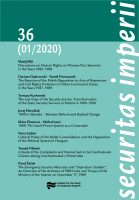1989: The Czech Prison System at a Crossroads
1989: The Czech Prison System at a Crossroads
Author(s): Klára Pinerová, Michal LoučSubject(s): Penology, Post-War period (1950 - 1989)
Published by: Ústav pro studium totalitních režimů
Keywords: János Kádár; György Aczél; the change to Hungary’s political/communist regime; consolidation; cultural policy of the Kádár regime; Hungarian Socialist Workers’ Party (MSZMP); state security;
Summary/Abstract: The Czechoslovak prison system was at a crossroads after 1989. It was clear to everyone that it would have to be humanised and modernised; and also that a system would have to be set up to ensure respect for convicts’ basic human rights. This was an elaborate task; complicated especially by the fact that a successful reform depended on many factors; from human resources to the economy of the newly established state. The paper explores three topics. The first part outlines the key trends in the prison system in the last years of the Communist Party dictatorship. After that; the authors analyse the situation in the prison system during the so-called Velvet Revolution in 1989 and shortly afterwards. That time saw repeated riots in the prisons; the establishment of prisoner organisations as well as prison staff who were critical of the previous development of prison system; and the start of the process of ridding the prison staff of its most compromised officers. The third part describes the post-revolution transformation of the basic operational principles of the Czechoslovak prison system; which can be summarised as depoliticisation; demilitarisation and humanisation. Keywords: Czechoslovakia (ČSSR); prison system; normalisation; Velvet Revolution (Sametová revoluce); abuse of prison system; humanisation of prison system; modernisation of prison system; prison riot; Charter 77 (Charta 77); dissent; 1989 Those who are not against us; are they with us? Cultural Policy of the Kádár Consolidation and the Opposition of the Political System in Hungary Nora Szekér When János Kádár and his government came into power in November 1956; after the October Revolution; it was terror deployed on a large scale that laid the foundations of Kádár’s so-called “consolidation” that followed the far from general amnesty; which was granted as a precondition of international acknowledgement. From the middle of the 1960s onwards; although Hungarian society did not come to like it; an increasingly large proportion of society came to accept the so-called “Kádárism” as the best that could be achieved in the given international framework. The dictatorship’s Hungarian variant now resorted to a more refined complex of means; such as subversion; indoctrination; propaganda; and severe existential constraints; instead of the spectacular open terror of earlier times. The regime was becoming less repressive; politics were taken out of everyday life and cultural liberalism was gaining ground. The spiritual father of this variant of cultural liberalism was György Aczél. He exerted a very sophisticated form of power. He called this “federal policy”; while others spoke of “favour management”. This policy was based on the principle that the opposition or potential opposition must not be intimidated; but made to become the obligors of the regime. In this playing field; free-thinking is not a narrow area of individual autonomy; but the result of a bargain. The study explains how the culture-politics of so-called Goulash Communism affected the operations of the Hungarian State Security; and how that affected the Hungarian opposition movements and the political changes in Hungary in 1989.
Journal: Securitas imperii
- Issue Year: 2020
- Issue No: 36
- Page Range: 124-169
- Page Count: 46
- Language: English

